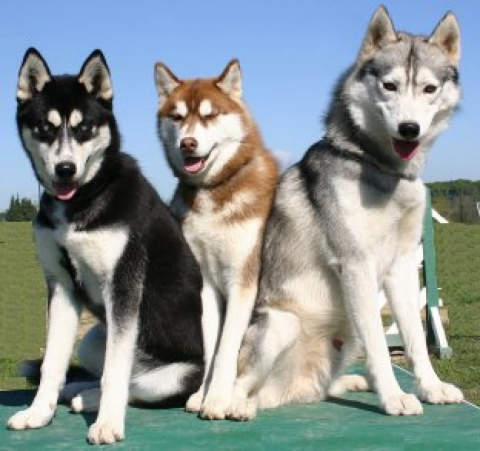
Siberian Husky, commonly known as Husky, is nicknamed Erha.
The Siberian Husky is a primitive and ancient dog breed, mainly living in northeastern Siberia and southern Greenland. The name of the Husky is derived from its unique hoarse call. Huskies have a changeable personality, some are incredibly timid, and some are incredibly violent. Huskies who have entered human society and families have no such extreme nature. They are relatively docile and are popular pet dogs all over the world. Husky, Golden Retriever, and Labrador are listed as the three significant non-aggressive dogs, which are widely bred by people worldwide, and there are a large number of competitions of this dog breed around the world.
The Siberian Husky is a medium-sized working dog. The footsteps are brisk, the movements are beautiful, the body is compact, with a thick coat, the ears are erect, and the tail is like a brush, showing the northern region's genetic characteristics.
The Siberian Husky is a breed very close to the wolf, so it looks like a wolf and has thicker hair than most dog breeds.
It is worth mentioning that "blue eyes, three fires," blue eyes refer to the eyes are blue; three fires refer to the three white marks on the forehead, which look like three burning flames. "Blue eyes, three fires" was once hyped by unscrupulous merchants as the standard for huskies. This has nothing to do with the CKU standard of huskies.
There are many types of dogs called huskies, and the term huskies in the usual sense are used to refer to all sled dogs in the north. The indigenous people of the Arctic initially raised huskies.
The Siberian Husky is a dog breed bred by the Inutchokzhi tribe, nomads of East Siberia. Huskies were originally used to pull sleds, participate in large-scale hunting activities, protect villages, and guide reindeer and guards. Moreover, work in the harsh environment of Siberia. The Siberian Husky has been growing alone in Siberia for centuries. In the early 20th century, it was brought to the United States by fur traders. In a blink of an eye, this dog became the champion dog of the world-famous sledding competition. Nowadays, this dog is loved by people as an excellent companion dog; in the historical records of the Siberian Husky, the ancestor of the Siberian Husky dates back to before the Neolithic Age. At that time, a group of hunters from Central Asia moved to the end of the polar region (Siberia) to live. After a long time, this group of dogs that followed the hunters, after mating and breeding with Arctic wolves for a long time, developed into the northern end. Dog breeds.
Among the people who crossed the Arctic Circle and finally chose to settle in Greenland, a tribe, the Chukchi, later developed the Siberian Husky. The Chukchi people use this wolf-like Husky as the most primitive means of transportation to pull sleds and use huskies to hunt and raise reindeer, or after breeding, bring them out of the frozen ground where they live in exchange for food and clothing. Huskies have become an essential property of the Chukchi people because they are small and robust in size, have a small appetite, are odorless and are very cold-resistant, and adapt to the polar climate. And this group of dogs, known as the Siberian Chukchi in the early days, is the later Husky's ancestor. It is said that the name husky is an Eskimo slang-the rumor of the hoarse call, because the dog barking at that time was relatively low and raspy, which gave it this excellent title.
Comments
Add Comment